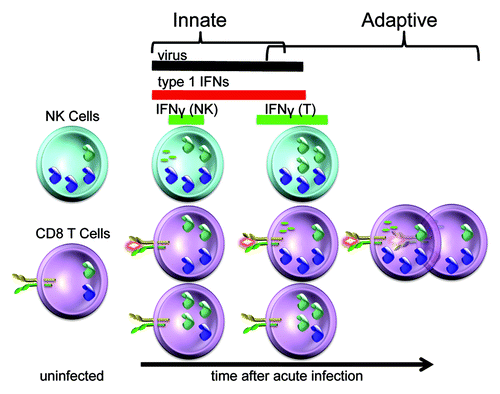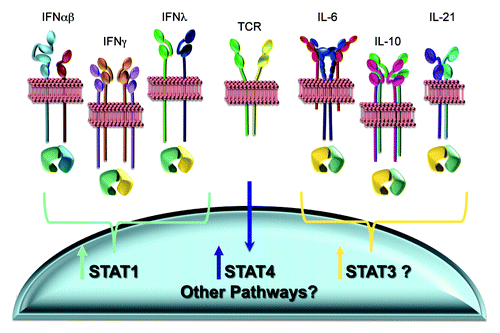Figures & data
Figure 1. Flexible use of STATs by type 1 IFNs in different cells. (A) Type 1 IFNs have been shown to be able to conditionally activate all of the STATs. The key pathways, however, use the preferred STAT1/STAT2 molecules to stimulate genes through ISRE and GAS promoters for induction of an antiviral state. (B) NK cells intrinsically express high levels of STAT4. As a result, exposure to type 1 IFNs initially activates STAT4 for IFNγ production by these cells. Eventually, STAT1 levels are increased and block receptor access to STAT4. (C) CD8 T cells have the potential to respond to type 1 IFN with either STAT1 or STAT4 activation, but the activation of STAT1 is preferred. During the context of responses to infection, the antigen-specific subsets have their STAT4, whereas the non-specific cells have STAT1, levels induced. As a result, antigen-specific CD8 T cells overcome type 1 IFN STAT1-dependent anti-proliferative effects and respond to type 1 IFN with STAT4 activation for IFNγ production. (See text for related references.)

Table 1. Key cytokine pathways to STAT1, STAT3 and STAT4 functions
Figure 2. Differential cellular use of type 1 IFNs for STAT4 activation and IFNγ production at particular times during LCMV infection. The LCMV infection in mice provides a powerful system to study the regulation of type 1 IFN effects. The cytokines are produced locally within a few hours and can be found systemically for several days following infection. Prior to infection, NK cell populations are high whereas the CD8 T cells are low for STAT4. As a result, NK cells initially respond to type 1 IFN with STAT4 activation and IFNγ production. The pathway is tightly regulated, however, because elevated STAT1 levels are concurrently induced to block type 1 IFN access to STAT4. In contrast, the antigen-specific CD8 T cells are being stimulated through their TCR to have elevated STAT4 expression whereas the non-specific CD8 T cells are induced to express elevated STAT1. These conditions promote preferential expansion of the antigen-specific CD8 T cells and their production of IFNγ in the context of the endogenous type 1 IFNs. Thus, there are flexible pathways in different cell types to regulate the consequences of type 1 IFN exposure during viral infection. (See text for related references.)

Figure 3. Known and potential pathways for changing intracellular STAT concentrations. A variety of cytokines, including all of the IFNs, preferentially activate STAT1, and STAT1 activation results in the induction of elevated STAT1 expression. Stimulation through the TCR leads to elevated STAT4. These pathways have been shown to be operational during viral infections. Other cytokines, including IL-6, IL-10 and IL-21, can activate STAT1 but have a preference for activating STAT3. STAT3 is reported to induce its own expression. Certain of these factors are also elicited during viral infections. Thus, there are a variety of potential known mechanisms for altering STAT3, and the potential for many unknown mechanisms for altering additional STATs, to further change intracellular concentrations of STAT mixes and the effects of any cytokine with the ability to alternatively activate particular STATs. (See text for related references.)
